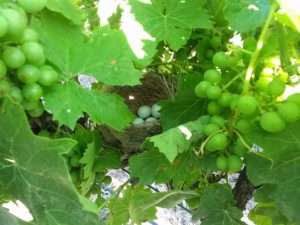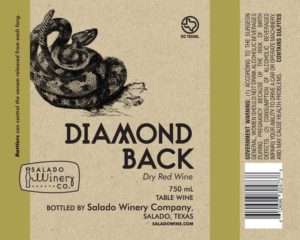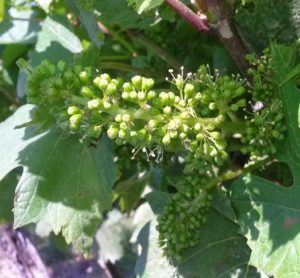Trying to Predict Harvest
 So here it is, almost mid-July and time to test the grapes and try to predict harvest. We tested the pH, TA and Brix along with visual examination, smell and taste testing. Pictured here is tempranillo from Journey Vineyards, merlot from our Salado vineyard and chardonnay from our Salado vineyard.
So here it is, almost mid-July and time to test the grapes and try to predict harvest. We tested the pH, TA and Brix along with visual examination, smell and taste testing. Pictured here is tempranillo from Journey Vineyards, merlot from our Salado vineyard and chardonnay from our Salado vineyard.
As you can see, the tempranillo has very red juice. Winemaker’s dream! The merlot hasn’t developed much color yet, and the chardonnay on the right, well, as a white, we don’t want too much color. You can also see the seeds in the picture. Still plenty of green seeds.
So the statistics?
From Belle Crest, Tempranillo: pH 3.21, Brix 19.2, TA 9.2 Malbec pH 2.94, Brix 16, TA 16 g/L plum, Cabernet Sauvignon pH 2.91, Brix 16.8, TA 17 g/L tart like orange juice
We predict Tempranillo harvest August 2nd, Malbec August 9th and Cab August 16 for Belle Crest
From our vineyard, Chardonnay was 1/2 green seeds and 1/2 brown, starting to golden, smells like apple cider, brown juice, green apple or pineapple flavor, pH3.21, TA 14 g/L, 14.5 degrees Brix, predict harvest on August 2nd
Merlot, too many green berries! very green seeds, brown juice, sweet carmel and plum smell, tart like orange juice taste, pH 3.08, TA 12.4 g/L, 12 degrees brix, predict harvest on August 9th
From Journey Vineyards, Tempranillo has green & beige seeds, almost fully colored grapes, nice pink juice, grape bubblegum and applesauce flavors, pH 3.15, TA 10 g/L, 13 degrees Brix, predict harvest August 9th
[pe2-image src=”http://lh3.ggpht.com/-HufNlpiVzks/U8Bi4rLsjhI/AAAAAAABh78/JVcuD0ELT98/s144-c-o/DSC02121.JPG” href=”https://picasaweb.google.com/102153593012294996679/20140724?authkey=tHHvpsoPu_U#6034932226480442898″ caption=” ” type=”image” alt=”DSC02121.JPG” ] [pe2-image src=”http://lh5.ggpht.com/-9C-ILEQWRr0/U8BMLY575pI/AAAAAAABh7o/05hX2JB5jWc/s144-c-o/DSC02109.JPG” href=”https://picasaweb.google.com/102153593012294996679/20140724?authkey=tHHvpsoPu_U#6034907259224188562″ caption=” ” type=”image” alt=”DSC02109.JPG” ] [pe2-image src=”http://lh6.ggpht.com/–_BhPtU7W6U/U8BL5KEZW3I/AAAAAAABh7c/yp3Qn9BJ_og/s144-c-o/DSC02110.JPG” href=”https://picasaweb.google.com/102153593012294996679/20140724?authkey=tHHvpsoPu_U#6034906946003884914″ caption=” ” type=”image” alt=”DSC02110.JPG” ] [pe2-image src=”http://lh5.ggpht.com/-pLBEeQ-cRHI/U8BLZOD4vjI/AAAAAAABh7E/9HLYnJ0F0ew/s144-c-o/DSC02112.JPG” href=”https://picasaweb.google.com/102153593012294996679/20140724?authkey=tHHvpsoPu_U#6034906397319675442″ caption=” ” type=”image” alt=”DSC02112.JPG” ] [pe2-image src=”http://lh5.ggpht.com/-Wn9H0m8Sbe4/U8BJdQdrBmI/AAAAAAABh5w/0m_A95bG9Ho/s144-c-o/DSC02115.JPG” href=”https://picasaweb.google.com/102153593012294996679/20140724?authkey=tHHvpsoPu_U#6034904267660920418″ caption=” ” type=”image” alt=”DSC02115.JPG” ] [pe2-image src=”http://lh6.ggpht.com/-TpY_oQ-hcEE/U8BGZqkbRlI/AAAAAAABh48/MJrNVBKN2TU/s144-c-o/DSC02106.JPG” href=”https://picasaweb.google.com/102153593012294996679/20140724?authkey=tHHvpsoPu_U#6034900907414210130″ caption=” ” type=”image” alt=”DSC02106.JPG” ]







